
by Cells4Life Middle East | Nov 4, 2019 | Cord Blood Banking
The world’s first umbilical cord blood transplant took place in France in 1988 – a fairly recent occurrence – where a young boy was cured of the life-threatening condition Fanconi anaemia, a hereditary disease that affects the bone marrow. Since then, more than 40,000...

by Cells4Life Middle East | Sep 1, 2019 | Cord Blood Banking, Cord Blood Stem Cells, Stem Cell News
Traditionally, doctors would discard the umbilical cord after a mother has given birth. They saw no value in this material and would simply throw it into the bin. This has all changed thanks to the discovery of powerful stem cells in umbilical cord blood and tissue....

by Cells4Life Middle East | Aug 19, 2019 | Cord Blood Banking
Umbilical cord blood contains stem cells that can be used to treat many life-threatening diseases. Cord blood is now widely recognised as being an important medical resource that should be preserved for future use. Many expecting parents are interested in storing cord...

by Cells4Life Middle East | Jul 15, 2019 | Cord Blood Banking, Cord Blood Stem Cells
Banking your child’s cord blood stem cells can change or even save a life. The lifesaving power of a newborn baby’s umbilical cord blood is no longer a secret. Cord blood stem cells are a better alternative to bone marrow in transplants, and have been used...

by Cells4Life Middle East | Jun 24, 2019 | Cord Blood Banking
After you have made the decision to store your child’s umbilical cord blood, you are given the option to have HLA tissue typing performed on the blood. This test is performed to help assess the compatibility of the stem cells with potential recipients. This kind of...







